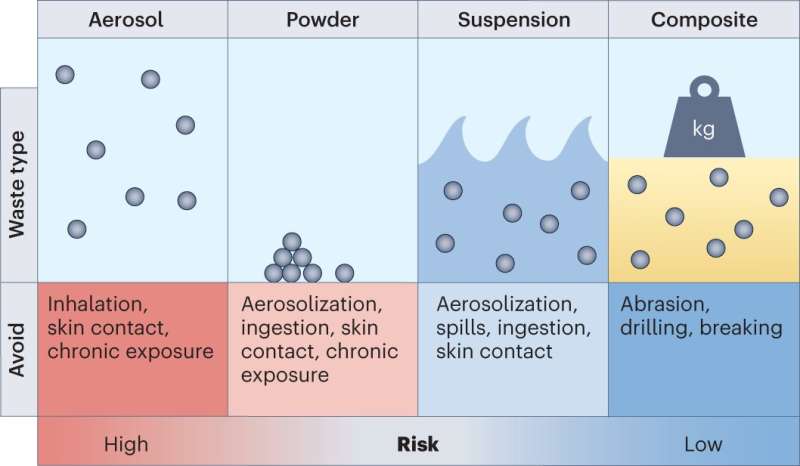This article has been reviewed according to Science X's editorial process and policies. Editors have highlighted the following attributes while ensuring the content's credibility:
fact-checked
peer-reviewed publication
proofread
Researchers call for better nanowaste management

Waste containing nanomaterials—or nanowaste—is an emerging safety concern worldwide, requiring environmentally sound management and regulation that still need to be established. Researchers at the University of Fribourg point out the gaps and provide first solutions for guidance.
Nanowaste includes manufacturing waste materials, end-of-life nano-enabled products, and waste (unintentionally) contaminated with engineered nanomaterials. More than 60 percent of engineered nanomaterials (up to 300,000 tons annually, and not including nanoplastics) are estimated to end up in landfill. And while there are currently no global definitions or classifications for nanomaterials or nanowaste, there is a need for tangible solutions related to risk assessment, categorization, labeling, collection, storage, transport, recycling, and elimination.
In a commentary in Nature Nanotechnology, researchers from the Adolphe Merkle Institute's BioNanomaterials group, along with colleagues from the University of Fribourg and EPFL, are advocating for awareness of the issue, and the need for technical and legally binding nanowaste guidelines strictly based on the precautionary principle. These should rely on state-of-the-art knowledge of nanomaterial behavior, and a lenient definition of nanomaterials.
Developing these initial guidelines requires case-by-case risk assessments of the specific nanowastes generated, a detailed understanding of national and international hazardous waste and materials regulations, and collaboration with laboratory staff to derive user-friendly ways to collect, store, and eliminate this waste.
As the researchers point out, a series of measures have already been implemented, in collaboration with the University of Fribourg safety officers, at the Adolphe Merkle Institute. These include proper labeling and storage, due to the absence of nanowaste-specific regulations, according to national and international hazardous material legislation, detailed guidelines on how to dispose of nanowaste correctly, and consolidation of this waste into a few legally permissible categories.
For research laboratories, such guidelines are especially important due to the high complexity of the waste generated, the presence of a great variety of untested materials, and the many different laboratory users, say the authors. More explicit rules for nanowaste, such as specific pictograms, could also help to harmonize nanowaste management in industry, prevent the misclassification of dangerous substances into nonhazardous categories, and avoid unintentional exposure of people and the environment to hazardous nanomaterials.
The recommendations presented in the article are targeted at researchers and policymakers in academia and industry. To protect human health and the environment, the authors urge increased awareness and action to manage nanowaste, as well as the explicit inclusion of nanowaste management into multinational agreements. They also caution policymakers to avoid double standards that would stifle the replacement of more hazardous conventional chemicals with novel, less harmful and degradable nanomaterials.
More information: Fabienne Schwab et al, The need for awareness and action in managing nanowaste, Nature Nanotechnology (2023). DOI: 10.1038/s41565-023-01331-4
Journal information: Nature Nanotechnology
Provided by Université de Fribourg



















